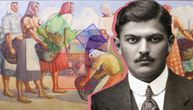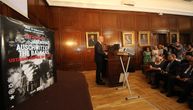Ustasha camp survivor Smilja Tisma's testimony: Baby was thrown against the wall, I covered my eyes
The Ustasha threw the child, it hit the wall. Its skull cracked. The mother was screaming, pulling her hair, Tisma remembers
Jasenovac, Stara Gradiska, Sisak, Jastrebarsko (Ustasha death camps in the Independent State of Croatia, NDH) - then an orphanage. These are the addresses where Smilja Tisma spent her childhood as a little girl from the ethnic Serb village of Zrinjska in Western Slavonia, Croatia. She survived the horrors and carried with her the imagery and the scars, Novosti writes.
"I was six or seven years old. I had a younger brother and two younger sisters. They don't remember the horror. My brother and I do. 'This is where that hook that they hung people on stood', we whispered when we first visited Jasenovac after the war. Our eyes froze in that place. While we were standing there, it was all in front of me: the last time I saw my father, he was the first to be taken to a camp. I took a change of clothes and some food to him and he told me:
"Run, Smiljo, run, child!" I never saw him again. There was the moment before me when they separated us from my mother and her message: "May St. Petka keep us safe." It must have been the day of our eternal goodbye.
New scenes of horrors were imprinted in the memory of a child who did not even know how old she was, but who knew that she was the only support for her little sisters and brother.
"I remember a bent, thin man in Jasenovac who was collecting dead children into a wheelbarrow," says Smilja Tisma.
"He would pick them up by the arm, by the leg and put them in the wheelbarrow. Every morning, that man filled the wheelbarrow and pushed it somewhere. But, when I think back now, I don't know if this image was scarier than when the Ustashas in Sisak were separating babies from their mothers. They would rip them off their breasts. One mother did not want to give her child away. The Ustasha threw the child, it hit the wall. Its skull cracked. The mother was screaming, pulling her hair. I covered my eyes with my hands. I pressed them hard with the palms of my hands."
From camp to camp, from horror to horror, to Jastrebarsko, a death camp for children.
"The crying of children kept coming from somewhere. We couldn't see them. We later learned that it was coming from a ward that had babies and children up to two and a half years old. We later learned that (Catholic) nuns smeared some poison around their mouths. They were telling them not to cry and not to be thirsty. Those children were dying in agony, and that is where screams and cries of those toddlers were coming from. Those cries wake me up, they will stay with me for as long as I live. I would not wish such a childhood on anyone and for it to last in such scars. That is why I am asking you to talk about the horrors in the NDH camps, to encourage us to talk about it, because if we don't - who will?!"
Smilja Tisma graduated from the Faculty of Law. Today, she is a member of the National Assembly of the Republic of Serbia.
(Telegraf.rs)

